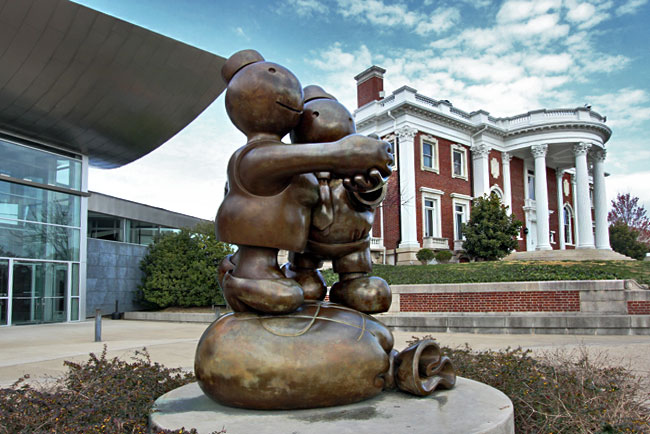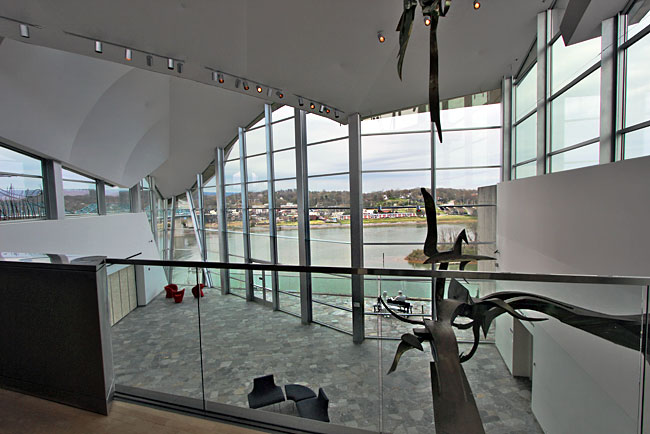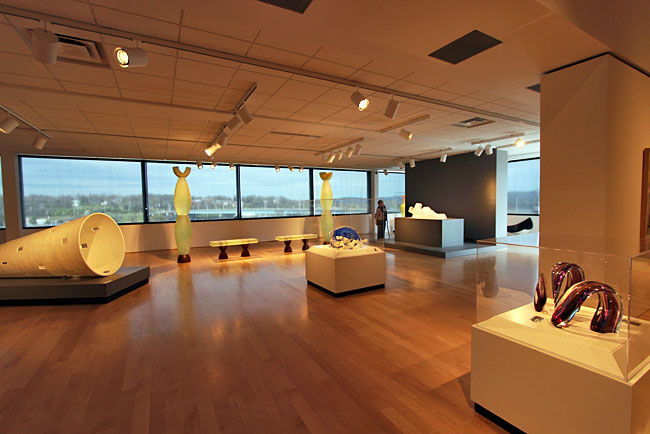I must confess that I find most museums tedious. The exceptions tend to be small, quirky museums like the East Martello Museum in Key West, which is home to Robert the Doll, said to be the source for the Chucky series of horror films, or those dedicated to culture, such as the Rafael Coronel Museo de Mascaras Mexicana (Mexican Mask Museum) in Zacatecas, Mexico. I will also happily fritter away an entire day in any art museum, thus when I found out the the Hunter Museum of American Art was just steps away from where I would be staying in Chattanooga, I made a beeline for it on my very first day.

Even before I entered, the Hunter changed my conception of a typical stuffy museum. The facility encompases three buildings that have been incorporated into the museum over more than 100 years. The original, a red brick Colonial revival style mansion, complete with classic white columns encircling a covered portico, contains the museum’s collection of early American art. Built in 1904 for a local insurance broker, the mansion was eventually sold in 1920 to the widow of Benjamin F. Thomas, whose husband had been one of the founders of the world’s first Coca-Cola bottling company. Her nephew, George Thomas Hunter, inherited the mansion upon her death. The younger Hunter had by that time become chairman of the board of the bottling company and is best known for creation of the Benwood Foundation, a private charitable trust that is still in existence today. George Hunter never married, thus when he died in 1951 his charitable foundation agreed to donate the house to the Chattanooga Art Association for use as an art museum.

By 1975, the museum was outgrowing the mansion, so a fortress-like concrete addition was built onto its rear. It was functional but not particularly attractive, despite the fact that it won numerous architectural awards. In 2005, when the museum again needed more space, they turned to architect Randall Stout, whose design drew from the site’s location high atop a natural rock promontory overlooking the Tennessee River. Stout describes his 28,000 square foot addition as a “contemporary interpretation of the rock outcroppings and strata within the cliff below, while the undulating forms of the roof reflect the dynamic movements of the neighboring river.” Though completely different than the other two structures, Stout’s addition reestablished the mansion as the focal point of the museum and drew the disparate architectural elements together.

Inside, more of my conceptions were challenged. The term “American art” had often seemed an oxymoron to me, as so many of our artistic traditions have come down to us from Europe. After the Civil War, most American artists lost interest in the classical landscape paintings that had depicted the country’s vast stretches of wilderness. Eager to prove themselves equal to European painters they embraced Impressionism with fervor. In the early twentieth century, European artists abandoned the idea that the subject matter of art had to be recognizable, ushering in the era of abstract art. Like lemmings, Americans rushed to make the new art form their own. However, I learned at the Hunter Museum that abstract art in American led to Pop Art, perhaps the best known example being Andy Warhol’s huge paintings of Campbell’s Soup Cans. This was a quintessentially American art form!

In another display I learned that the United States was the birthplace of the studio glass movement. Traditionally, glass could only be made in factory settings but advances in technology in the 1960’s allowed individual artists to become involved in all aspects of the process. The studio glass movement spread to the rest of the world and continues to be nourished by innovations in form and technology developed in America.

As the afternoon waned I wandered into the exhibit on traditional American decorative arts and furniture. A small notebook sitting on a wooden pedestal explained to children that the objects were some of the most prized possessions of Americans during Victorian times, and invited them to draw a picture or write down the name of their most prized possession on a page in the notebook. I expected most of the entries to be materialistic, such as the drawings of an iPod, skateboard and jeep. But to my surprise, the majority were not commercially driven. One said, “My great grandfather’s watch chain. He fought in World War II and he was in the D-Day 101st jump. The chain was with him, so it is history. It’s priceless.” Another said, “My malachite meditation stone because it reminds me of lessons I’ve learned when I’ve forgotten them.” A third wrote, “My camera freezes time. Preserves moments of humanity.”
That afternoon, I left the Hunter Museum with a different point of view, not only about what a museum should look like or whether there are any true American art forms, but also with my faith restored in American youth, which I sometimes see as much too focused on material possessions.
Disclosure: I was a guest of the Chattanooga Area Convention & Visitors Bureau during my stay in Chattanooga. However, the receipt and acceptance of complimentary items or services will never influence the content, topics, or posts in this blog. I write the truth, the whole truth, and nothing but the truth.

Sounds like a cool museum. I saw a similar statue to your first photo in Toronto few weeks ago. I really liked it!
I enjoyed reading your blog. The Hunter is a wonderful. The glass art is very unique and hard to find such a beautiful piece of Art.
It is such a beautiful museum. I always like looking at these work of art.
Hi Paula: It is a great museum – hope you get to visit someday.
That glass art is amazing! The things people can do now-a-days is so spectacular! Someday I hope to visit the museum here!
Hi Leslie: The glass are blew me away, too. There were some incredible huge blown glass pieces that I didn’t even show on the site. And there are several studio shops in town featuring glass art – I’ve not seen that anywhere else.
Wow, what a great place! I’m sure I will have a very fun if I have an opportunity to go over there! Thank you for great photo shot and great info.
I enjoyed reading your blog. The Hunter is a wonderful institution and a great asset to the community.
Hi Carnetta: So glad you enjoyed my article on the Hunter Museum. I loved Chattanooga and hope to return someday soon. Thanks or leaving a comment.
Thanks so much for visiting with us and for sharing this wonderful blog. I loved seeing the museum through your eyes and hope you will visit again when you are next in town!
Adera Causey, Curator of Education, Hunter Museum
Hi Adera: Thanks so much for visiting my site and taking time to leave a comment. As Curator of Education for the Hunter Museum, your kind words meant a lot to me. As you can probably tell by my article, I love Chattanooga, and I’m certain I’ll visit your museum again and again.